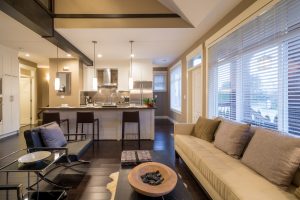Share This
Related Posts
Tags
Real Estate Design
By Erica Rascón on Apr 23, 2020 in News
Shelter in place practices have made an impact on every industry in America. Multitenant industrial and retailers grasp to make rent while grocers, tech, and delivery firms thrive. We naturally attach value to such changes. Real estate and its design, however, are neutral reflectors of social shifts. Like events before it, COVID-19 is the next big thing to change the face of housing.
But first, let’s look back at other shifts that have changed the way that we live.
We’ve seen this before – sort of
Major social and economic events directly impact that way that we design and inhabit real estate. Following the wreckage of the Great Depression, President Franklin D. Roosevelt’s New Deal propelled the development of interstates and suburbs. Subdivisions sprang up, dispersing families into nuclear households. By the mid-1940s, middle class workers’ commutes prompted the addition of built-on garages. With the cheap suburban lots, greater car affordability, and adequate employment rates of the 1960s, many families opted for large houses with two-car garages.
Fast forward to the economic prosperity of the 90s. Middle class and affluent Americans indulged in spacious homes with open floor plans. Multifamily construction boomed, answering demand from young adults who struck out on their own. Most formed their own households after graduation. In 2005, only 19% of college graduates lived with or moved back in with their parents, reports MarketWatch.
The Great Recession ended lavish living for most Americans. Homeowners and investors struggled with mortgages, inundating the market with foreclosures. As the Great Recession dragged on, multitudes of seniors moved in with their adult kids. The number of recent graduates moving back into their parents’ homes jumped to 28% in 2016. The nuclear households of the 50s-90s began to disappear. Multigenerational housing reemerged and real estate changes followed soon after.
Coming full circle to multigenerational housing with a twist
Around 2012, multigenerational housing became the “new” trend in single family real estate. Though multigenerational households were the standard for thousands of years, modern multigen housing offered greater privacy. Finished basements with separate entries increased in popularity. Homes with two masters on the main floor thrived since they could support the homeowners as well as their aging parents. In price points that accommodated larger lots, young adults or in-laws lived in detached suites that shared mortgage and utilities costs.
Young adults who would not or could not move in with family weathered the hard times in their apartments. Roommate floor plans were hot, especially when equipped with equally-sized private bedrooms and en suite bathrooms. Young adults postponed homeownership.
Green building reasserts itself
As the world shrugged off the burdens of the Great Recession, many eyes shifted to the next big thing in sustainable housing. Urban infill properties and mixed-use buildings brought residents closer to the businesses and services they used most. As a result, both classes reduced transportation pollution and costs. Between 2010-2019, tiny houses, micro apartments and co-living blossomed as way to reduce housing costs and environmental impact.
Inside of their homes, residents implemented artificial technology to promote conservation and cut costs. Smart thermostats, lights, and appliances have become more commonplace. In addition to saving money and resources, residents crave greater control of our homes even when we were outside of it.
Little did we know that we be spending so much time at home in 2020.
COVID-19: the death of open floor plans?
March 2020 marked sweeping shelter in place practices throughout the US. The sustainable measures of the past decade helped to decrease housing expenses, but other real estate changes are being reevaluated.
Residents of mixed-use and infill properties are feeling the pain of stay at home policies. Public green spaces are closed and few units have more than a balcony for access to the outdoors. Psychologically, being surrounded by closed businesses isn’t reassuring.
 Smart home tech comes with benefits and disadvantages during the COVID-19 lockdown. The conveniences that they provide are welcome, though home automation devices drain precious bandwidth. This can lead to poor quality Zoom calls and slower load time for media pertaining to work and school. Families are also learning about Wi-Fi dead zones in their homes and scrambling to find solutions.
Smart home tech comes with benefits and disadvantages during the COVID-19 lockdown. The conveniences that they provide are welcome, though home automation devices drain precious bandwidth. This can lead to poor quality Zoom calls and slower load time for media pertaining to work and school. Families are also learning about Wi-Fi dead zones in their homes and scrambling to find solutions.
The luxury of open layout floor plans is also less appealing. Multigenerational households undoubtedly share the joys of togetherness, but too much togetherness leads to tension. Adults and children alike struggle to distinguish quiet places to work from entertaining places to play. Mom works in the kitchen, dad works in the dining room, and kids are sprawled in front of the living room TV—each vying for strong internet connection.
None of those distinctions matter because furniture sets alone delineate spaces in an open layout. The open floor plan improves the efficacy of the central Wi-Fi, but noises travel between rooms, interrupting conference calls and final exams. It’s hard to focus. There is a bit too much togetherness.
Change is in the air
Pandemic mitigation will impact the near future of residential spaces. There are five major changes that we can expect in post-coronavirus housing.
First, we’re likely to see designated rooms make a comeback. Shoppers will reconsider the value of houses with more delineated spaces. Once extraneous spaces such as the library and parlor will be seen for their multifunctional appeal.
Of those designated spaces, storage is essential. Stocking up on goods allowed families to adhere to stay at home policies. Future home seekers will remember their stocked pantries with mixed emotions but will nonetheless see the importance of large pantries and spacious garages.
Developers will reimagine their package delivery solutions. In this decade, planned communities phased out mailboxes in favor of tidy mail stations. In the future, stations will likely offer oversized lockers as a value-add feature.
The importance of strong wi-fi connectivity throughout the home is already evident. Moving forward, it will be non-negotiable. Home wiring will reflect multiple connection points and internal antennas to promote consistent connectivity. Alongside smart home tech we will see a rise in demand for residential wifi repeaters, boosters and extenders.
Additionally, lots with acreage—once seen as more upkeep than they are worth—will re-emerge as wise investments. Limited access to the outdoors was a major pain point for families during shelter in place practices. The value of private space to play, relax, and explore will be even more valuable than before.
We aren’t out of the woods yet
As global trade and travel become more accessible, the pandemic risks remain. Buyers will evaluate homes for features that could help them thrive during shelter in place policies.
